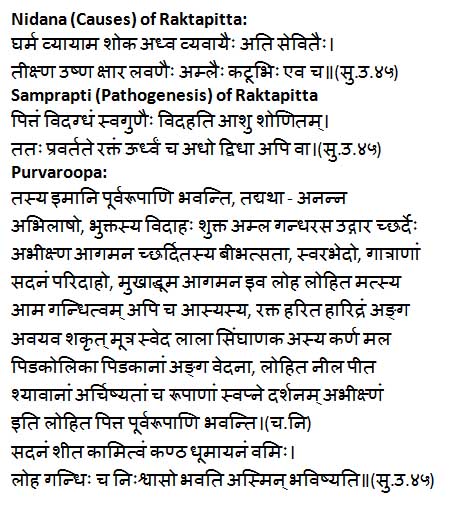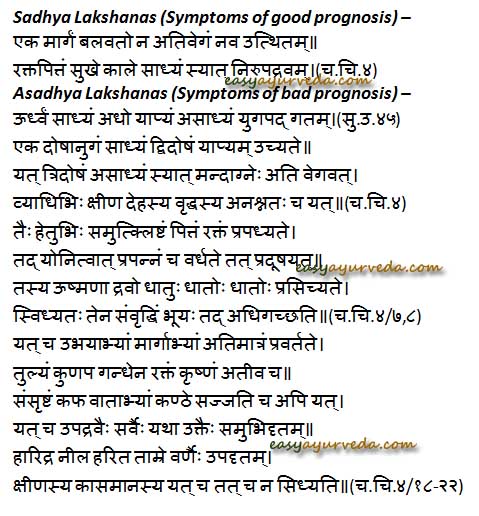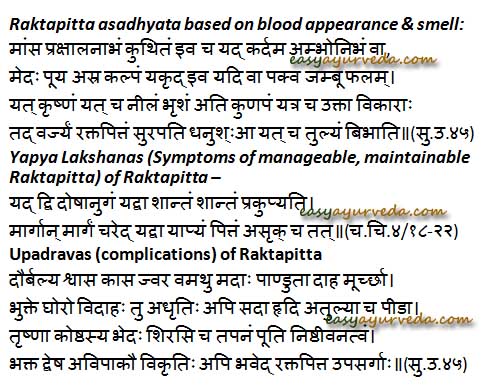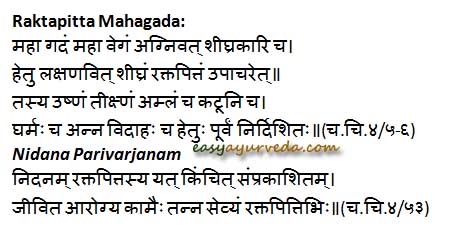Raktapitta Causes, Symptoms, Pathology, Treatment, Medicines, Remedies
Article by Dr Raghuram Y.S. MD (Ay) & Dr Manasa, B.A.M.S
Raktapitta is a bleeding disorder wherein the blood (rakta) vitiated by pitta flows out of the orifices (openings) of the body. Bleeding occurs due to some internal cause or as an effect of some chronic and stubborn diseases and importantly in the absence of injury.
Related Reading Raktapitta: Cluster Of Bleeding Disorders: Meaning, Definition
Table of Contents
Causes
Nidana (Causes) of Raktapitta
Below mentioned are the causes (etiological factors) of Raktapitta disease –
- Gharma / Aatapa – Excessive exposure to heat of Sun
- Vyaayaama – Excessive physical exercise
- Shoka – Excessive grief
- Adhwa – Excessive walking
- Vyavaaya – Excessive indulgence in sexual activities
- Teekshna – Excessive consumption of intense, strong and damaging foods
- Ushna – Excessive consumption of hot foods (hot to touch)
- Kshaara – Excessive consumption of alkalis or alkaline foods
- Lavana – Excessive consumption of salts or salty foods (or tastes)
- Amla – Excessive consumption of sour foods (or tastes)
- Katu – Excessive consumption of pungent and spicy foods (or tastes)
- Vidahi Anna – Corrosive food

Gross causative factors –
According to Charaka,
- Urdhwaga Raktapitta (raktapitta in which the bleeding of contaminated blood takes place in the upward directions and from upward passages or orifices) is caused by Snigdha-Ushna sevana (consumption of unctuous and hot foods together)
- Adhoga Raktapitta (raktapitta in which the bleeding of contaminated blood takes place in the downward directions and from downward passages or orifices) is caused by Ruksha-Ushna sevana (consumption of dry and hot foods together)
Pathogenesis
Samprapti (Pathogenesis) of Raktapitta
Why does Raktapitta occur?
The disease Raktapitta develops and manifests as the pathogenesis runs through the below mentioned steps in that order –
- Pitta aggravated by the above said causes leaves its sites and reaches rakta (blood).
- Being a mala (waste product) of rakta, the pitta on getting mixed with rakta attains quantitative increase.
- The pitta in turn vitiates the rakta. Due to the heat of Pitta, the drava dhatu or the liquid portion (fluid) of other tissues like mamsa (muscles), meda (fat) etc oozes out of their respective tissues and gets admixed with rakta.
- This further enhances the quantity of rakta, beyond the limits of normal quantity.
- This also enhances the quantity of blood flowing in the blood vessels creating immense pressure in the blood vessels.
- Due to the pressure of the blood and heat of pitta, the walls of the blood vessels get damaged and the blood starts flowing through various openings of the body.
- Bleeding occurs through mouth, nose, ears, eyes, skin, anus, penis and vagina.
- This bleeding of blood vitiated by pitta through various orifices of the body is called Raktapitta.
Acharya Sushruta explains the Samprapti (pathogenesis) of Raktapitta in a simple way and tells –
The pitta which becomes vidagdha (burnt or corroded) by the above mentioned etiological factors quickly reaches the rakta (blood) and causes its vidaha (burns the blood). This rakta contaminated by vikrita (vitiated) and vidagdha pitta flows out of the orifices in the upward or downward or in both directions. While flowing upwards, the bleeding in raktapitta occurs through nasa (nasal openings), akshi (eyes), karna (ears) and aasya (mouth). The raktapitta flowing downwards bleeds through medhra (urinary passages in men and women), yoni (vagina in women) and guda (anal opening). Severely aggravated raktapitta moves side-ways and bleeds through the orifices in the skin (romakupas)
Premonitory symptoms
Poorvarupa (premonitory symptoms) of Raktapitta
- Ananna abhilasha – loss of interest in food
- Bhuktasya vidaha – burning (very quick digestion?) of consumed food
- Shukta amla gandha – smell of sour fermented liquid (from the mouth)
- Shukta amla rasa – taste of sour fermented liquid (sour and fermented liquid) from the mouth
- Shukta amla udgaara – sour belching or belching having taste of fermented liquid
- Abheekshna chardi – severe, uncontrolled and projectile vomiting
- Charditasya bheebatsataa – scary look and gesture of the person who has vomited
- Swara bheda – hoarseness of voice
- Gaatra sadana – feeling of tiredness in the whole body
- Paridaaha – feeling of burning sensation in the body
- Mukhaad dhuma aagamana iva – feeling as if the fumes are coming out of the mouth
- Loha gandha – smell of iron from the mouth
- Lohita gandha – smell of blood from the mouth
- Matsya gandha – smell of fish (fishy odor) from the mouth
- Rakta harita haaridratwam anga avayava shakrut mootra sweda laalaa singhaanaka aasya karna mala – Reddish, greenish and turmeric colored discoloration of body, body parts, feces, urine, sweat, saliva, nasal dirt or discharges, oral dirt or discharges and ear discharges
- Anga vedana – body pains
- Lohit neela peeta shyaavaanaam archishyataam cha roopaanaam swapne darshanam abheekshnam iti – ferocious and scary figures having red, blue, yellow or bluish black color are seen in dreams
- Shiro gurutwam – heaviness of head (Vagbhata)
- Aruchi – tastelessness (Vagbhata)
- Kasa – cough (Vaghata)
- Shwasa – dyspnoea, shortness of breath (Vagbhata)
- Bhrama – giddiness (Vagbhata)
- Klama – fatigue (Vagbhata)
- Sheeta kaamitwam (Sushruta)

Routes and Dosha association
Raktapitta Marga and Dosha samsarga (Routes of Raktapitta and dosha association)
Based on the direction of flow of vitiated blood (blood vitiated by pitta), Raktapitta is said to be of 2 types i.e.
Urdhwa Raktapitta – Raktapitta in which bleeding occurs in upward direction, from orifices in the upper parts of the body. Caused by Snigdha Ushna Sevana – associated with Kapha Dosha. Leads to movement of Rakta in upward direction and bleeding through nostrils, eyes, ears, nose.
Adhoga Raktapitta – Raktapitta in which bleeding occurs in downward direction, from orifices in the lower parts of the body. Caused by Ruksha Ushna sevana, associated with Vata Dosha. Leads to downward movement of Rakta and bleeding through urinary passages, vagina, anal orifice.
Ubhaya margaga Raktapitta – Caused by combination of the above two, with influence of Vata and kapha Dosha. Leads to movement of Rakta in both upper and lower direction and leads bleeding through all orifices. mentioned passages.
Classification
Classification of Raktapitta
Raktapitta is classified as follows –
Based on the direction of bleeding:
- Urdhwaga Raktapitta
- Adhoga Raktapitta
Based on the dosha predominance:
- Kaphaja
- Vataja
- Pittaja
- Vata-Pittaja
- Vata-Kaphaja
- Kapha-Pittaja
- Tridoshaja Raktapitta
Symptoms
Lakshanas (symptoms) of Doshaja Raktapitta
Kaphaja Raktapitta – In the raktapitta associated with kapha, the blood is thick (Sandra), pale (pandu varna) and unctuous (snigdha).
Vataja Raktapitta
In the raktapitta associated with Vata, the blood will be blackish blue or blackish brown (shyava) or reddish yellow or golden yellow (aruna) in color, thin / dilute (tanu), dry (ruksha) and associated with froth (sa phenam)
Pittaja Raktapitta
In the Raktapitta associated with Pitta, the blood will have black (Krishna) or decoction like (kashayabham) color. The blood resembles the urine of cow (gomutra sannibham), with mixture of many colors (mechaka). It will also have resemblance with agara dhuma (soot of chimney) and collyrium (anjanabham).
Dwandwaja Raktapitta
(Raktapitta having association of 2 doshas) – In Vatapittaja, Vatakaphaja and Kaphapittaja Raktapittas, symptoms of 2 doshas will be present in mixed proportions
Sannipataja Raktapitta
Sannipataja or Tridoshaja Raktapitta – In Raktapitta caused by association of all the 3 doshas, the symptoms of all the 3 doshas will be present in mixed proportions
Prognosis
Raktapitta is a condition in which the blood contaminated with pitta flows out of the orifices of the body, both in upper and lower parts of the body and also through the orifices in the skin.
Related Reading Raktapitta: Cluster Of Bleeding Disorders: Meaning, Definition
Sanskrit verse

Since Raktapitta is a bleeding disorder, the bleeding should be controlled with efficient treatment and disease modifying medicines. The doctor also should know when to stop the blood and when not to do it. One should also know the limitations of treatment. For this comprehensive knowledge of the prognosis (which condition is curable and which not) and complications associated with Raktapitta is mandatory. In this article I will focus on the above said aspects of the disease.
Sadhya Lakshana
Sadhya Lakshanas (Symptoms of good prognosis) –
- Eka margam – Raktapitta moving in only in one direction (unidirectional bleeding), especially in upward direction (urdhwa gati raktapitta)
- Eka doshanugam – Caused by predominance of only one (vitiated) dosha
- Urdhwaga Raktapitta – Raktapitta which moves in upward direction
- Balavato – Raktapitta occurring in strong people
- Na ati vegam – Raktapitta which is not ferocious in terms of quality, quantity and frequency
- Nava uttitam – Raktapitta which is newly manifested (acute)
- Sukhe Kale – Raktapitta which occurs in favorable season i.e. Shishira and Hemanta (cold seasons, favorable and antagonistic to raktapitta which occurs due to heat predominant causes)
- Nirupadravam – Raktapitta devoid of complications
- Read related: Raktapitta Causes, Premonitory Symptoms, Symptoms, Pathogenesis
Asadhya Lakshana
Asadhya Lakshanas (Symptoms of bad prognosis) –
- Yugapad Margam (Ubhayaabhyaam maargam – Charaka) – Raktapittam moves both in upward and downward direction
- Samsrushtam Kaphavaataabhyaam – Associated with both kapha and vata
- Tridoshaja Raktapitta- Raktapitta associated or caused by all three vitiated doshas
- Mandagnehe – Raktapitta occurring in those having sluggish digestion or weak metabolism as evident by loss of hunger and indigestion
- Ati vegavat – Raktapitta which is ferocious in terms of quality, quantity and frequency
- Atimaatram pravartate – Severe bleeding
- Vyaadhibhihi ksheena dehasya (ksheenasya – Charaka) – Raktapitta occurring in those whose body has been emaciated or become weak as an effect of chronic and long standing illnesses
- Vruddhasya – Raktapitta occurring in old aged people
- Kaasamaanasya – Raktapitta associated with cough
- Anashnatascha – Raktapitta occurring in people who have rejected food
- Kante sajjati cha api – Raktapitta getting obstructed in the throat
- Raktam Pashyed Drishyam – All objects and also the sky appears red, bloody red in color
- Lohita Chardi – vomiting of blood (Sushruta)
- Lohita akshnaha – reddish eyes (Sushruta)
- Lohita udgaara – taste and smell of iron in belching (Sushruta)
- Lohita darshi – all objects are seen red (Sushruta)
- Upadravaihi sarvaihi yathoktaihi samabhidbhutam – associated with all the complications (mentioned below)

Raktapitta asadhyata based on the appearance and smell of blood –
Raktapitta is said to be asadhya or having bad prognosis when it has below mentioned type of appearances, smell and other features –
- Mamsa prakshaalanaabham – Meat wash appearance
- Kuthitam – foul smelling
- Kardama ambu sannibham – muddy water
- Meda pooyasra kalpam – as if mixed with fat and pus
- Yakrud iva – color and consistency of liver
- Pakwa jambu phalaabham – appearance of ripe fruit of Jambu
- Krushnam – blackish
- Neelam – bluish
- Ati kunapam – smell of dead body
- Surapati dhanushaa tulyam – Having all colors of rainbow
Yapya Lakshana
Yapya Lakshanas (Symptoms of manageable, maintainable Raktapitta) of Raktapitta –
Raktapitta with below mentioned features is said to be Yapya i.e. manageable or maintainable
- Dwidoshaja Raktapitta – Raktapitta caused by vitiation of 2 doshas
- Adhogam Raktapittam – Raktapitta which has downward course (passes in downward direction)
- Yad wa shaantam shaantam prakupyati – Raktapitta whose bouts recur repeatedly after getting pacified
- Maargaat maargam charet – Raktapitta whose course keeps shifting from one direction to the other, i.e. the bleeding sometimes occurs in upward passages and direction and at other times in downward direction, from downward orifices (passages)
Upadrava
Upadravas (complications) of Raktapitta
Below mentioned are the upadravas or complications of Raktapitta, whose presence makes Raktapitta asadhya (incurable).
- Dourbalyam – weakness
- Shwasa – dyspnea, shortness of breath
- Kasa – cough
- Jwara – fever
- Vamathu – vomiting
- Mada – intoxication
- Panduta – pallor of the body, anemia
- Daha – burning sensation
- Moorcha – fainting, unconsciousness
- Bhukte ghoro vidaaha – severe burning immediately after taking food
- Adhruti – loss of courage
- Sadaa hrudi atulya peeda – constant intolerable pain in the region of heart
- Trushna – thirst
- Koshtasya bheda – diarrhea
- Shirasi tapanam – increased heat in the head
- Pooti nishteevanatwam – foul smell in the sputum
- Bhakta dwesha – aversion or loss of interest towards food
- Avipaka – indigestion
- Vikritihi api – presence of abnormal colors and odors of raktapitta as mentioned above
Treatment Principles Of Raktapitta
Article by Dr Raghuram Y.S. MD (Ay) & Dr Manasa, B.A.M.S
Raktapitta is a bleeding disorder in which the blood contaminated by vitiated Pitta bleeds through the orifices of the body, both in upward and downward directions, including the skin orifices.
Related Reading Raktapitta: Cluster Of Bleeding Disorders: Meaning, Definition
Raktapitta is a clinical emergency
Raktapitta is a clinical emergency and should be treated as quickly as possible, without any delay. Otherwise it is going to cause serious threat to life.
Sanskrit verse

Acharya Charaka mentions Raktapitta as a Mahagada (disease which is difficult to manage) and calls for quick action.
Charaka –
Raktapitta is a Mahagada (dreadful disease) which has Mahavega (having severe intensity in terms of heavy bleeding which is life-threatening) and is Sheeghrakari (that which destroys the body quickly just as a small spark of fire destroys a big heap of grass, i.e. quickly brings about death of an individual). Therefore a wise physician who has a clear-cut knowledge of the causative factors and signs and symptoms of raktapitta, i.e. a physician who has skills of diagnosing this condition as quickly as possible should treat it immediately, without any delay.
Treatment principles
Principles of treatment of Raktapitta
Nidana parivarjana
Nidana Parivarjanam – Avoiding the causative factors is the key
In any disease, avoiding the causative factors is considered as the prime approach towards healing. Even in Raktapitta this rule holds good. The patients of Raktapitta desirous of good health and life should keep away all the causative factors which are mentioned in Raktapitta Nidana i.e. causes of Raktapitta. These include foods and lifestyle practices which cause vitiation of pitta and rakta (blood).
Read related: Raktapitta Causes, Premonitory Symptoms, Symptoms, Pathogenesis
Stambhana
Stambhana – Bleeding should not be stopped initially
In the initial stages of Raktapitta, stambhana treatment – measures targeting stoppage of bleeding should not be given. Since in Raktapitta it is not the pure blood but in fact is the blood contaminated with pitta that is flowing through bleeding, stambhana should not be given. The blood should be allowed to flow if the strength, muscle bulk and appetite of the patient has been preserved and are in good condition. In weak people stambhana should be immediately given.
Read related: Stambhana in Raktapitta: Styptic Therapy In Bleeding Disorders
Langhana, Tarpana & Peya – Lightening and Nutritive Therapies, Digestive liquid diets (gruels)
After allowing the bleeding to occur in the initial phases of Raktapitta, the below mentioned strategies should be planned.
Langhana
Lightening treatment to digest ama (unprocessed digestive juices in circulation, caused due to sluggish digestion) are administered initially
Read related: Langhana Therapy – A Unique Ayurvedic Treatment Principle
Tarpana
After Langhana, Tarpana – nutritious herbal drinks and diet including vegetables and meat (and meat soup) should be administered in Urdhwaga Raktapitta (Raktapitta having upward course)
Tarpana is given in different forms. They are –
- Tarpana in the form of medicated drinks
- Tarpana in the form of Yavagu (medicated gruels)
- Tarpana in the form of Ahara (diet, including leafy vegetables, dhanya i.e. grain, food, mamsarasa i.e. meat soup etc)
Peya
Digestive liquid diet especially in the form of gruels should be given after Langhana in Adhoga Raktapitta (Raktapitta having downward course)
Read related: Role of Langhana, Tarpana and Peya in the treatment of Raktapitta
Diet in Raktapitta
Nutrition is essential in Raktapitta to combat complications of bleeding, to regularize metabolism and to provide strength to the patient.
Bhojana is provided in different forms, mainly in the form of Tarpana as mentioned above. Ayurveda has given a gist of essential and beneficial dietetic inclusions in Raktapitta. They are –
- Yavagu – medicated gruels
- Anna – cooked rice
- Shaka – Leafy vegetables and food stuff prepared from them
- Yusha Supa – Drinks and soups
- Dhanya – Grains and millets and food stuff prepared from them
- Mamsarasa – meat soup
Yusha, Shaka, Mamsarasa
Preference of Yusha, Shaka and Mamsarasa in Raktapitta
- In Raktapitta having Kapha Anubandha (association of kapha) i.e. Urdhwaga Raktapitta (Raktapitta having upward course, bleeding through nose, ears, eyes, mouth) – Yusha (soups and drinks) and Shaka (leafy vegetables and dishes prepared from the same) shall be used
- In Vata Anubandha Raktapitta (Raktapitta associated with Vata) i.e. Adhoga Raktapitta (Raktapitta having downward course, bleeding through anus, urinary tract and vagina) – Mamsa rasa (meat soup) should be preferably administered
Management of thirst
Principles of management of thirst in Raktapitta
Thirst is a common complaint in Raktapitta. This occurs due to severe blood loss and fluid loss. Thirst should be managed with top priority.
After having analyzed the strength of dosha, associated doshas (Kapha, Vata), atura bala (strength of the patient) and ahara shakti of the patient (capacity to take food), water shall be given as and when desired until the thirst comes down and the patient starts feeling better. Alternatively, small quantities of water shall be fed to the patient at regular intervals.
In presence of thirst in Raktapitta below mentioned forms of water should be given –
- Water processed with bitter tasting herbs
- Juices of fruits which alleviate thirst
- Vidarigandhadi Gana sidda jala – Water processed with Vidarigandha group of herbs
- Shruta sheeta jala – Boiled and cold water
- Hreeberadi Paniya – Water processed with Hrivera (Coleus vettiveroides / Pavonia odorata), Raktachandana (Red Sandalwood), Usheera (Vetiveria zizanioides), Musta (Cyperus rotundus) and Parpataka (Fumaria parviflora)
Shodhana
Shodhana in Raktapitta (Panchakarma in Raktapitta)
Shodhana, especially Vamana (therapeutic emesis) and Virechana (therapeutic purgation) should be given in Raktapitta in patients whose bala (strength) and mamsa (muscle mass) are not reduced, if the Raktapitta is caused due to santarpana (excessive saturation), if there is bahu dosha (excessive morbidity) in the body of the patient, if there are no associated upadravas (complications) and if the patient is an eligible candidate to undergo Shodhana.
Pratimarga harana
Pratimarga Harana Chikitsa
In the treatment of Raktapitta, the doshas should be expelled from the opposite route of their course (opposite to the direction of bleeding). Following this pattern, Virechana should be administered in Urdhwaga Raktapitta (bleeding in upper passages, in upward direction) and Vamana should be administered in Adhoga Raktapitta (bleeding in lower passages, in downward direction).
After Vamana, Tarpana i.e. nourishing drinks and food should be administered in Urdhwaga Raktapitta and Yavagu, i.e. gruels (when Vayu is in control) or mamsarasa i.e. meat-soup (in vitiation of vata) should be administered in Adhoga Raktapitta.
Samshamani kriya
Samshamani Kriya
Medicines and formulations to pacify vitiated Pitta should be administered as a part of Samshamani Kriya. In this, many formulations including herbal teas, powders etc are administered. Samshamani also includes disease modifying medicines.
Mutramarga gata Raktapitta
Management of Mutramarga gata raktapitta (bleeding from urinary tract)
Shatavari Gokshura siddha ksheera – Milk processed with decoction of Shatavari (Asparagus racemosus) and Gokshura (Tribulus terrestris)
Chaturparni siddha ksheera – Milk processed with Shalaparni (Desmodium gangeticum), Prishniparni (Uraria picta), Mudgaparni (Phaseolus trilobus) and Mashaparni (Teramnus labialis)
Gudamarga gata Raktapitta
Management of Guda marga gata raktapitta (bleeding from rectum)
Mocharasa siddha ksheera – Milk processed with paste of Mocharasa (Gum of silk cotton tree)
Vata siddha ksheera – Milk processed with paste of shoots of Vata (Banyan tree)
Hreeveradi kalka siddha ksheera – Milk processed with paste of Hrivera (Coleus vettiveroides, Pavonia odorata), Neela utpala (blue variety of lotus) and Nagara (ginger)
Nasagata Raktapitta
Management of Nasa gata raktapitta (bleeding from nose)
Bleeding of blood contaminated with pitta from the nose is called Nasagata Raktapitta. This condition is categorized as subtype of Urdhwaga Raktapitta and should be addressed immediately.
Ghrita in Raktapitta
Use of herbal ghee in in Raktapitta
Medicated ghee should be used in Raktapitta to combat severe and stubborn bleeding. Some of the Ghritas which are highly beneficial in Raktapitta are –
- Vasa Ghrita
- Palasha Ghrita
- Vatsaka Ghrita
- Trayamana Ghrita
- Audumbara Ghrita etc
Kshara in Raktapitta
Use of Kshara (alkalis) in Raktapitta
Kshara – alkalis should be used in Kaphanubandha Raktapitta (Raktapitta associated with kapha). When Kapha gets associated with Raktapitta, the blood gets clogged (clot) and blocked in the throat. Kshara should be used in this condition. The Ksharas of the below mentioned should be used in grathita raktapitta –
- Utpala nala kshara – alkali prepared from petioles of water lily
- Padhmaka kesara Kshara – alkali prepared from stamens of lotus
- Mrunala Nala Kshara – alkali prepared from petioles of Mrunala, variety of lotus
- Utpala kesara kshara – alkali prepared from stamens of water lily or blue variety of lotus
- Palasha kshara – alkali prepared from Butea monosperma
- Priyangu kshara – alkali prepared from Callicarpa macrophylla
- Madhooka Kshara – alkali prepared from Madhooka longifolia
- Asana kshara – alkali prepared from Pterocarpus marsupium
Bahya Chikitsa
Bahya Chikitsa (external treatments) in Raktapitta
Though Raktapitta is a bleeding disorder in which the bleeding should be controlled from within, external treatments are equally necessary to combat pitta and rakta. The external maneuvers include abhyanga, parishechana (sprinkling of medicated fluids over the body), pradeha (anointment of medicated pastes), sheeta upachara (cold comforts) etc.
Samshamani Kriya indicated conditions
Conditions for administration of Samshamani Kriya
In patients of Raktapitta, Samshamani Kriya should be advised (implemented) in the below mentioned conditions –
- Bala mamsa pariksheenam – Loss of Bala (strength) and Mamsa (muscle bulk
- Shoka karshitam – patient emaciated due to excess grief
- Bhara karshitam – patient emaciated due to carrying excessive and heavy weights
- Adhwa karshitam – patient emaciated due to excessive walking
- Jwalana Santapta – fire burns
- Aditya santapta – sun burns
- Anyaihi aamayaihi ksheenam – patient emaciated due to chronic or long standing illnesses
- Garbhini – pregnant woman
- Sthaviram – old aged people
- Baalam – children
- Ruksha ashinam – those eating dry foods
- Alpa ashinam – those eating less quantity of food
- Pramita ashinam – limited diet or food
- Avamyam – patients in whom Vamana cannot be administered (or not fit for vamana)
- Avirechyam – patients in whom Virechana cannot be administered (or not fit for virechana)
- Shosha anubandha – when raktapitta is associated with shosha or rajayakshma (wasting diseases, tuberculosis, phthisis)
Shamshamani Kriya comprises of administering medicines, herbs and formulations which have disease modifying effect (action) especially in the presence of the above said conditions.
Read related: Tarpana and Ahara in the treatment of Raktapitta
Medicines and formulations
Samshamani Kriya – Medicines and Formulations for Raktapitta
Kwathas (herbal decoctions)
Atarooshakadi Kwatham – Decoction or infusion of Vasa Patra (leaves of Adhatoda vasica), Mrudwika (raisins) and Haritaki (Terminalia chebula) mixed with sugar and honey
Padhmakadi Kwatham – Paste of Padhma kashta (stem of Prunus cerasoides), Padhma kinjalka(stamens of lotus flower), Durva (Cynodon dactylon), Vastuka (Lamb’s quarter, Wild spinach, Chenopodium album), Utpalam (blue variety of lotus, water lily), Nagakeshara (Mesua ferrea) and Lodhra (Symplocos racemosa) mixed in decoction of Vasa (Adhatoda vasica)
Prapaundarika (Nymphaea lotus) and Madhuka (Licorice)
Bala Kwatha – Decoction of Bala (Sida cordifolia) mixed with powder of mudga (green gram), laja (parched rice, puffed paddy), yava (barley), pippali (long pepper), ushira (Vetiveria zizanioides), Musta (Cyperus rotundus) and Chandana (sandalwood)
Shakrud Rasa Yoga (formulations in fluid extract or liquid portion of animal feces)
Paste of Prapaundarika (Nymphaea lotus) and Madhuka (Licorice) mixed in Ashwa Shakrud Rasa (liquid portion of horse feces)
Paste of Yavasa mula (root of Alhagi camelorum) and Bhringaraja mula (root of Eclipta alba) mixed in Go shakrud rasa (liquid portion of cow feces), should be taken with rice wash water
Gomaya shakrid rasa (liquid portion of cow feces) and Ashwa shakrid rasa (liquid portion of horse feces) mixed with honey and ghee
Churna (herbal powders)
Khadiradi Churna – Powder of Khadira (Acacia catechu), Priyangu (Callicarpa macrophylla), Kovidara (Bauhinia variegata) and Shalmali (flowers of Salmalia malabarica) mixed with honey
Sringatakadi Churnam – Powder of Shringataka (Trapa bispinosa), Laja (puffed paddy), Musta (Cyperus rotundus), Kharjura (dates) and Kamala kesara (stamens of lotus flower) mixed with honey
Ushiradi Churnam – Powder of:
- Ushira (Vetiveria zizanioides)
- Kaaleeyaka (Yellow sandalwood)
- Lodhra (Symplocos racemosa)
- Padhma kashta (stem of Prunus cerasoides)
- Priyangu (Callicarpa macrophylla)
- Katphala (Myrica nagi)
- Shanka bhasma (ash of conch)
- Gairika (red ochre)
- Chandana (lotus)
The powder of the above said should be taken mixed with tandula dhavana (rice wash) and sharkara (sugar)
The above mentioned churna can be taken as a whole formulation or individual herbs mentioned in the formulation can be taken in the below mentioned forms –
- Sheeta Kalpana – The churna or powder of individual ingredients shall be dipped in water overnight, filtered and taken first thing in the morning
- Swarasa – Fresh juice of all or individual ingredients
- Kalka – Paste of all or individual ingredients
- Mrudita or Phanta – Hot infusion of all or individual herbs
- Kwatha – Decoction of all or individual herbs (ingredients)
Peya
Peya in Raktapitta (drink)
Usheeradi Peya – Drink made out of Ushira (Vetiveria zizanioides), Padma (lotus), Utpala (water lily) and Chandana (sandalwood) prepared after dipping the powders of these herbs in water overnight and filtering them should be taken after adding sugar and honey, first thing in the morning
Loshta Peya – Drink made after immersing Pakwa Loshta (powder of new earthen pot) in water overnight and filtering it should be taken after adding sugar and honey, first thing in the morning
Priyangwadi Peya – Drink made after immersing Priyangu (Callicarpa macrophylla), Chandana (sandalwood), Lodhra (Symplocos racemosa), Sariva (Hemidesmus indicus), Madhooka (Madhuca longifolia), Musta (Cyperus rotundus), Abhaya (Terminalia chebula) and Dhataki (Woodfordia fruticosa) mixed with Loshta Jala (water dipped with powder of earthen pot) and Shashtika Jala (water washed with rice grown in 60 days) should be taken mixed with sugar
Management of Vatanubandha
In spite of the agni (digestion, metabolism) getting rectified and kapha getting pacified after the administration of Kashayas and other Samshamani Kriyas, if the raktapitta doesn’t get alleviated and if bleeding keeps recurring it indicates the association of vitiated Vata i.e. Vata has not been taken into control (Vatanubandha).
To control Vata and to stop the bleeding, the below mentioned measures shall be done –
Chaga paya – Initially goat’s milk should be given mixed with sugar and honey
Go dugdha – Cow’s milk processed with 5 times water should be given mixed with sugar and honey
Vidarigandhadi gana (Laghu Panchamula or lesser 5 roots) siddha dugdha – Milk processed with Laghu Panchamula should be given mixed with sugar and honey
Draksha Shrutam Paya – Milk processed with draksha (raisins) mixed with sugar
Nagara Shrutam Paya – Milk processed with nagara (ginger) mixed with sugar
Bala Shrutam Paya – Milk processed with roots of bala (Sida cordifolia) mixed with sugar
Gokshura Shrutam Paya – Milk processed with gokshura (Tribulus terrestris) mixed with sugar
Jeevaka Rishabhaka Shrutam Paya – Milk processed with jeevaka (Malaxis acuminata) and rishabhaka (Manilkara hexandra) mixed with ghee of cow and sugar
Ghritas in Raktapitta
Medicated Ghee is very useful in severe bleeding related to Raktapitta, especially bleeding from urinary tract, rectum and nose. Below mentioned are the most effective ghritas (ghee) in Raktapitta.
Vasa Ghrita – Ghee prepared with kwatha (decoction) of branches, leaves and roots of Vasa plant (Adhatoda vasica). This ghee should be taken mixed with honey.
Palasha siddha ghrita – Ghee processed with juice and paste of leaves and petioles of Palasha (Butea monosperma) should be given mixed with ¼ the quantity of honey
Vatsaka Ghrita – Ghee processed with paste of Vatsaka (seeds of Holarrhena antidysenterica)
Samangadi Ghrita – Ghee processed with Samanga (Mimosa pudica), Utpala (water lily) and Lodhra (Symplocos racemosa) should be given mixed with ¼ the quantity of honey
Trayamana Ghrita – Ghee processed with Trayamana (Gentiana kurroo) should be given mixed with ¼ the quantity of honey
Udumbara-Patola Ghrita – Ghee processed with Udumbara (Ficus racemosa) and Patola (Pointed gourd) should be given mixed with ¼ the quantity of honey
Shatavaryadi Ghrita – Ghee processed with Shatavari (Asparagus racemosa), Dadima Pushpa (flowers of pomegranate), Tintideeka (Rhus parviflora), Kakoli (Roscaea procera), Meda (Polygonatum cirrhifolium), Yashtimadhu (Licorice), Vidarikanda (Pueraria tuberosa) & Phalapuraka (Citrus medica)
Traditional formulations
Traditional formulations (classical medicines) for Raktapitta
- Bolabaddha Rasa
- Chandrakala Rasa
- Pravala Panchamrita
- Raktapittantaka Lauha
- Kamadhgha Rasa
- Godanti Bhasma
- Pravala Pishti
- Usheerasava
- Lodhrasava
- Pushyanuga Churna
Proprietary medicines
- Tab Ayapon (Alarsin)
- Tab Caparin (Arya)
- Cap Point (Ayulabs)
- Tab Posex Forte (Charak)
- Tab Styplon (Himalaya)
- Liquid Surodhini (Nanjangud)
- Liquid Ultivin (Imis)
- Tab Arshonyt (Charak)
- Tab Pilex (Himalaya)
- Tab Pilocure (Alopa)
- Cap Pilogems (Fort Herbal)
- Cap Pilonil (Dindayal)
- Tab Pilorid (Nagarjuna)
- Tab Pirrhoids (Baidyanath)
- Cap Pylapy (Capro)
- Tab Rectacare (Anuja)
- Tab Rectocare (Bacfo)
- Tab Peptilin (Arya)
- Tab Berb-Enterone (Sandu)
- Cap Bilva (Vitalcare)
- Tab Diarex (Himalaya)
- Cap Dicinil (Fizikem)
- Tab Entoform (Manil)
- Tab Entostal (Solumiks)
- Tab Kosht-Sanjivini (Pavaman)
- Tab Kutajadi (Pavaman)
- Cap Mebarid (Phyto Pharma)
Sahasra Yoga Medicines
Yogas mentioned in Sahasra Yoga Text Book
Raktapittahara Kashaya
Tiktaka Ghrita
Mahatiktaka Ghrita
Ikshu Doorvadi Ghrita
Vrisha Ghrita
Mahakushmanda Ghrita
Balaguduchyadi Taila
Chandanadi Taila
Sitopaladi Choorna
Chandanadi Choorna
Tugadi Choorna
Kachooradi Choorna (Laghu)
Asokarishta
Usirasava
Kushmanda Rasayana
Satavari Guda
Kutajavaleha
Kautajadi Guda
Brihadvasavaleha
Vatapitta jvarahara Kashaya
Trishnahara Kashaya
Panduhara Kashaya
Vata Raktahara Kashaya
Duralabhadi Kashaya
Hriberadi Kashaya
Usirdi Kashaya
Chandanadi Kashaya
Satavaryadi Kashaya
Trayantyadi Kashaya
Single herbs
Single herbs useful in Raktapitta
- Vasa – Adhatoda vasica
- Shatavari – Asparagus racemosa
- Kutaja – Holarrhena antidysenterica
- Vatsaka – Seeds of Holarrhena antidysenterica
- Yashtimadhu – Licorice
- Udumbara – Ficus racemosa
- Trayamana – Gentiana kurroo
- Samanga – Mimosa pudica
- Utpala – water lily
- Padhma kinjalka – stamens of lotus flower
- Kamala kesara – stamens of lotus flower
- Padma – lotus
- Padhma kashta – stem of Prunus cerasoides
- Utpala – water lily
- Lodhra – Symplocos racemosa
- Palasha – Butea monosperma
- Jeevaka – Malaxis acuminate
- Rishabhaka – Manilkara hexandra
- Gokshura – Tribulus terrestris
- Bala – Sida cordifolia
- Draksha – raisins
- Laghu Panchamula – lesser 5 roots
- Go dugdha – Milk of Cow
- Chaga Paya – Milk of goat
- Priyangu – Callicarpa macrophylla
- Chandana – sandalwood
- Sariva – Hemidesmus indicus
- Madhooka – Madhuca longifolia
- Musta – Cyperus rotundus
- Abhaya – Terminalia chebula
- Dhataki – Woodfordia fruticosa
- Ushira – Vetiveria zizanioides
- Kaaleeyaka – Yellow sandalwood
- Katphala – Myrica nagi
- Shringataka – Trapa bispinosa
- Laja – puffed paddy
- Kharjura – dates
- Khadira – Acacia catechu
- Kovidara – Bauhinia variegata
- Shalmali – flowers of Salmalia malabarica
- Durva – Cynodon dactylon
- Nagakeshara – Mesua ferrea
Apathya
Apathya in Raktapitta
Apathya or unwholesome foods are touched upon in the context of Nidana of Raktapitta
Related reading –Raktapitta Causes, Premonitory Symptoms, Symptoms, Pathogenesis
Pathya Apathya – Yogaratnakara
Wholesome herbs, diet and habits
Barley, wheat, rice, soup of meat of animals living in desert like land, green gram, pigeon pea, red lentil etc.
Unwholesome herbs, diet and habits
Heat of fire, exposure to sunlight, fatigue, foods that aggravate Pitta, sexual intercourse, anger, wandering etc.
Effective Decoctions For Bleeding Disorders From Sahasrayogam
Raktapittahara Kashayam
Ref – Sahasrayogam, Kashaya Prakaranam, 14
a. Shatavaryadi Kashayam
| Ingredients | Botanical Name | Method of using | Indications |
| Shatavari | Asparagus racemosus | The decoction prepared with these ingredients should be served fresh | 1. Bleeding from upper and lower orifices of the body 2. Intermittent fevers associated with burning sensation 3. Insanity 4. Menorrhagia |
| Krishna Sariva | Hemidesmus inducus | ||
| Sandalwood | Santalum album | ||
| Ushira | Vetiveria zizanioides | ||
| Hrivera | Pavonia odorata | ||
| Tanduliyaka | Amaranthus spinosus | ||
| Grapes | Vitis vinifera | ||
| Manjishta | Rubia cordifolia | ||
| Utpala | Nymphaea stellata | ||
| Licorice | Glyzyrrhiza glabra |
b. Vata Shringadi Kashayam
| Ingredients | Botanical Name | Method of using | Indications |
| Vata sringa | Ficus benghalensis | The decoction prepared with these ingredients should be served fresh by mixing it with the milk | 1. Bleeding disorders |
| Vasa | Adhatoda vasica |
c. Chandanadi Kashayam
| Ingredients | Botanical Name | Method of using | Indications |
| Sandalwood | Santalum album, sandalwood | The powders of these ingredients should be mixed in the decoction of Sida cordifolia and be kept overnight. It should be given for oral consumption the next morning. | Cures – 1. Bleeding disorders |
| Ushira | Vetiveria zizanioides | ||
| Musta | Cyperus rotundus | ||
| Laja | Parched / puffed grains | ||
| Green gram | Vigna radiate, green gram | ||
| Pippali | Piper longum | ||
| Barley | Hordeum vulgare, barley | ||
| Manjishta | Rubia cordifolia | ||
| Utpala | Nymphaea stellata | ||
| Licorice | Glyzyrrhiza glabra |
2. Drakshadi Kashayam (Vata-Pitta Jwarahara Kashayam)
Ref – Sahasrayogam, Kashaya Prakaranam, 6
| Ingredients | Botanical Name | Method of using | Indications |
| Grapes | Vitis vinifera | The decoction prepared with these ingredients should be served with honey, sugar and powder of parched grains. | 1. Fever of vata-pitta origin 2. Alcoholic intoxication 3. Vomiting 4. Fainting 5. Burning sensation 6. Giddiness 7. Fatigue 8. Bleeding from upper passages 9. Thirst 10. Jaundice |
| Madhooka | Madhuca longifolia | ||
| Licorice | Glycyrrhiza glabra | ||
| Lodhra | Symplocos racemosa | ||
| Kashmarya | Gmelina arborea | ||
| Sariva | Hemidesmus indicus | ||
| Musta | Cyperus rotundus | ||
| Gooseberry | Emblica oficinalis | ||
| Hrivera | Pavonia odorata | ||
| Padmakesara | Filament of lotus | ||
| Padmaka | Prunus cerasoides | ||
| Mrinala | Nelumbium speciosum | ||
| Sandalwood | Santalum album | ||
| Ushira | Vetiveria zizanioides | ||
| Nilotpala | Nymphaea stellata | ||
| Parushaka | Grewia asiatica |
3. Sarivadi Kashayam (Trishnahara Kashayam)
Ref – Sahasrayogam, Kashaya Prakaranam, 33b
| Ingredients | Botanical Name | Method of using | Indications |
| Sariva | Hemidesmus indicus | The decoction prepared with these ingredients should be served fresh | 1.Burning sensation 2.Bleeding disorders 3.Thirst 4.Fever |
| Ushira | Vetiveria zizanioides | ||
| Kashmarya | Gmelina arborea | ||
| Madhooka | Madhuca longifolia | ||
| white and red types of sandalwood | Santalum album & Pterocarpus santalinus | ||
| Licorice | Glyzyrrhiza glabra | ||
| Parushaka | Grewia asiatica |
4. Vasaguluchyadi Kashayam (Panduhara Kashayam)
Ref – Sahasrayogam, Kashaya Prakaranam, 46b
5. Shatavari Chinnaruhadi Kashayam (Vataraktahara Kashaya)
Ref – Sahasrayogam, Kashaya Prakaranam, 62b
| Ingredients | Botanical Name | Method of using | Indications |
| Shatavari | Asparagus racemosus | The decoction prepared with these ingredients should be served fresh mixed with powder of Glycyrrhiza glabra | 1.Gout 2.Bleeding disorders |
| Guduchi | Tinospora cordifolia | ||
| Amlaki | Emblica officinalis | ||
| Bala | Sida cordifolia | ||
| Ikshu kanda | Stem of Saccharum officinarum | ||
| Sugarcane juice | Juice of Saccharum officinarum |
6. Duralabhadi Kashayam
Ref – Sahasrayogam, Parishishta Prakaranam, 11
| Ingredients | Botanical Name | Method of using | Indications |
| Duralabha | Fagonia cretica | The decoction prepared with these ingredients should be served fresh with sugar | 1. Thirst 2. Bleeding disorders 3. Fever with burning sensation |
| Parpataka | Fumaria oficinalis | ||
| Priyangu | Callicarpa macrophylla | ||
| Bhunimba | Andrographis paniculata | ||
| Vasa | Adhatoda vasica | ||
| Katukarohini | Picrorhiza kurrooa |
7. Hriberadi Kashayam
Ref – Sahasrayogam, Parishishta Prakaranam, 15
| Ingredients | Botanical Name | Method of using | Indications |
| Hrivera | Pavonia odorata | The decoction prepared with these ingredients should be served fresh, mixed with honey and sugar | 1.Severe bleeding disorders, thirst, fever and burning sensation |
| Coriander | Coriandrum sativum | ||
| Ginger | Zingiber oficinale | ||
| Sandalwood | Santalum album | ||
| Licorice | Glycyrrhiza glabra | ||
| Vasa | Adhatoda vasica | ||
| Ushira | Vetiveria zizanioides |
8. Usiradi Kashayam
Ref – Sahasrayogam, Parishishta Prakaranam, 16
| Ingredients | Botanical Name | Method of using | Indications |
| Ushira | Vetiveria zizanioides | The decoction prepared with these ingredients should be served fresh with honey | 1.Bleeding disorders |
| Sandalwood | Santalum album | ||
| Patha | Cissampelos pariera | ||
| Grapes | Vitis vinifera | ||
| Madhuka | Glyzyrrhiza glabra | ||
| Pippali | Piper longum |
Ref – Sahasrayogam, Parishishta Prakaranam, 18
10. Satavaryadi Kashayam
Ref – Sahasrayogam, Parishishta Prakaranam, 19
| Ingredients | Botanical Name | Method of using | Indications |
| Shatavari | Asparagus racemosus | The decoction prepared with these ingredients should be served fresh | Cures – 1.Bleeding disorders 2.Colic |
| Bala | Sida cordifolia | ||
| Rasna | Pluchea lanceolata | ||
| Kashmarya | Gmelina arborea | ||
| Parushaka | Grewia asiatica |
Ref – Sahasrayogam, Parishishta Prakaranam, 111
Yogas mentioned in Sahasra Yoga Text Book
Raktapittahara Kashaya
Tiktaka Ghrita
Mahatiktaka Ghrita
Ikshu Doorvadi Ghrita
Vrisha Ghrita
Mahakushmanda Ghrita
Balaguduchyadi Taila
Chandanadi Taila
Sitopaladi Choorna
Chandanadi Choorna
Tugadi Choorna
Kachooradi Choorna (Laghu)
Asokarishta
Usirasava
Kushmanda Rasayana
Satavari Guda
Kutajavaleha
Kautajadi Guda
Brihadvasavaleha
Click to Consult Dr Raghuram Y.S. MD (Ayu)










One comment on “Raktapitta Causes, Symptoms, Pathology, Treatment, Medicines, Remedies”
Dr Aamna
Sr what are the pH values of jeera water and ajwain water ?